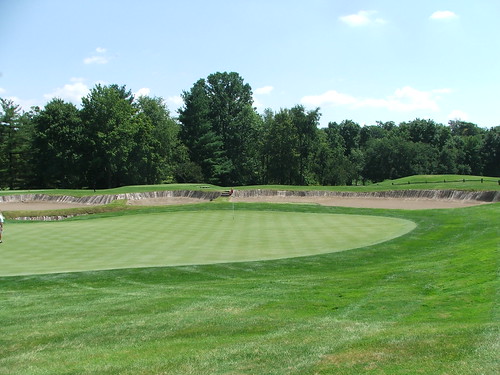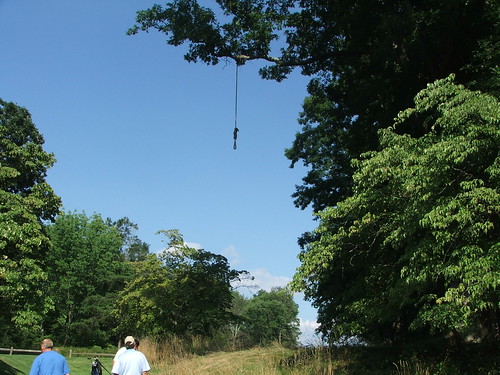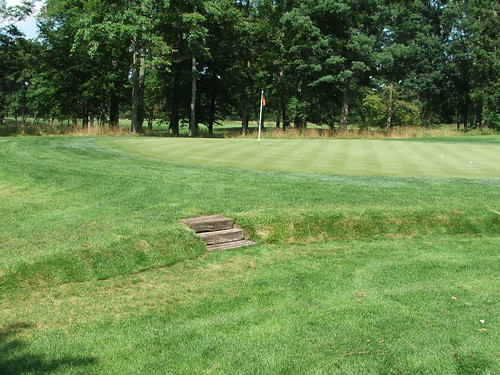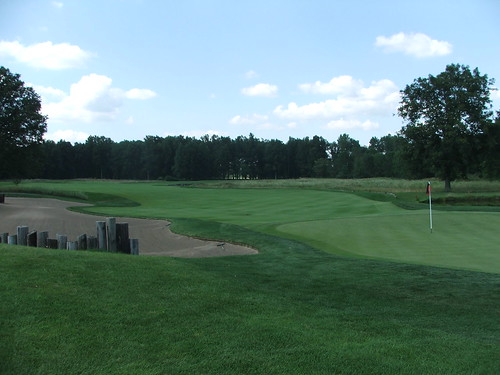
"Hit 'till you're happy."
Not a bad way to start a round of golf. These were the instructions from our host as we stood on the first tee at The Golf Club. The Golf Club (ranked #48 in the world) is probably the highest ranked golf course in the United States that few people have ever heard of. Located in New Albany, Ohio, near Columbus, the course was designed by Pete Dye in 1967. It is a very early Pete Dye design and he used local Jack Nicklaus, then twenty-seven years old, to help him verify some of the potential shot selections as he was designing the course.
The course was the brainchild of Fred Jones, who wanted a course where he didn't have to wait for tee times. F. Scott Fitzgerald was right when he said that the very rich are different than you and me. I have to wait for tee times and accept it as part of the game. It must be nice to have enough money to build your own course when you don't want to wait. The Golf Club doesn't get a lot of play, thus the local custom is to hit until you're happy on the first tee. I have the feeling I'm going to like The Golf Club.
In his book Bury me in a Pot Bunker, Pete Dye says, "When I began sketching ideas for The Golf Club, images of two golf courses built in the 1920s came to mind. Along with the Scottish courses and Pinehurst No. 2, the design features at Seminole and Camargo influenced many of the characteristics prevalent at The Golf Club." I haven't played Camargo yet, but I really didn't see similarities to Pinehurst or Seminole, particularly regarding the greens, which are key aspects of both courses.

The third green with railroad ties in the background
There really isn't a bad hole on the course, but the stretch of holes from twelve through sixteen are the most brilliant. The 369 yard par four thirteenth is a world-class hole that doglegs to the left off the tee. Dye made extensive use of sawed off telephone poles in the bunker right of the green. As with many great short par fours, it is a classic risk-reward hole where the further to the left you hit the ball the more you will be rewarded, but it also brings the flowery hazard to the right, seen in the picture below, into play.
The par four thirteenth looking back from the green
The par five fourteenth is a big hole in all respects. It is 639 yards from the back tees, the fairway is big (100 yards wide) and uneven; the bunker on the right side of the hole is mammoth, and the green is challenging.
Sixteen is a challenging 200 yard par three that plays over a gorge to a relatively small, well-bunkered green. As the number sixteen stroke index hole, it's a doozy. After failing several times to finish the hole, Fred Jones installed a full size hangman's noose on the branch of the magnificent 270-year-old white oak that overhangs the green.

The hangman's noose high up in a tree by the 16th hole
Like Garden City Mens Club, Pine Valley and Augusta National, the Golf Club is an all-male club. I came away with a very favorable impression of The Golf Club, and I think that these lesser known courses by Pete Dye such as this and the Honors Course in Tennessee surpass his better known courses such as Whistling Straits or the TPC Stadium course. Also, I'm getting too old to be beaten up by a golf course. The Golf Club is challenging but is easily the type of course you can play every day and not tire of because it is a great walking course. The locker room at The Golf Club is in a similar style to that at Seminole and Ocean Forest, with lockers ringing the room and seating in the middle.
The bridge over Blacklick Creek on the sixth hole has an old railroad box car as a bridge. My picture shows what the bridge would look like if you had a half dozen beers before teeing off.

Box car bridge on the sixth hole
The club history states that The Golf Club, "...was not founded as a family recreation or amusement center. It was founded as a men's club without the need for starting times and with the excitement and turmoil which too frequently results from the crowds attracted to a multipurpose sports or recreation club." Translation: leave the women and children home.
If I had to give The Golf Club a grade, I would give it an "A". There is really nothing lacking and it is a great place to spend a day playing golf and hanging out in the locker room.



No comments:
Post a Comment